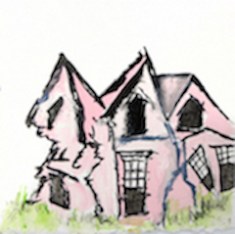
Eve Wood. The Artists’ Prison. Photo Courtesy of Ochi Projects.
Eve Wood and Alexandra Grant, The Artists’ Prison
Ochi Projects
By Jody Zellen
Through July 2nd
The Artists’ Prison is a book of fiction written by Alexandra Grant and illustrated by Eve Wood that describes the imagined crimes and punishments of over forty prisoners housed in a Kafka-esque environment as told to a nameless Commander by a similarly nameless Warden. In the heavily redacted text, Grant outlines the plights of individuals described as: the Water Artist, the Blind Draftsman, the Narcissist, The Pinhole Camera Artist, etc. Wood’s illustrations open each dialogue providing visual interpretations of the prisoner’s conundrums.
Installed in sequential order on the gallery wall are Wood’s intimate (6 x 6 inch) gouache, graphite and oil stick drawings. Each ragged-edged-square of handmade paper displays either a subtlety or garishly colored drawing that indirectly alludes to the written text while also standing on its own. These drawings are violent, compassionate, haunting, bitter, suggestive, sexual, frightening, pleading, complicit and accepting. Rather than illustrate Grant’s prose, Wood uses the text as a point of departure to create a visual narrative about pain, suffering, despair and hope.

Eve Wood. The Artists’ Prison. Photo Courtesy of Ochi Projects.
Prisoner 30 (all works 2017) on the checklist (and the image adjoining Prisoner 33, The Fire Artist in the book) is a close-up image of an eye on fire. While the text refers to the fire in the prisoner’s eye, Wood illustrates this notion with force and intensity as delicate vein-like flames protrude from an isolated eye. Prisoner 31 recalls Philippe Petit’s tightrope walk between the world trade towers. Wood positions the silhouette of a man carrying a large stick for balance between two yellow and gray skyscrapers. Seen outside the context of the book, this vulnerable albeit stoic figure clearly flirts with danger. Prisoner 6, is the Invisible Prisoner. This is mostly a pencil drawing proclaiming I AM NOT HERE. The word NOT is painted in a drippy style and the drips from the N lead to a small figure. The drawing suggests the figure walked through the words leaving a trail. While in the book, this prisoner has never been seen by the Warden, he/she is clearly present. Prisoner 20 is an architect and is represented by a disjointed pink house.
Grant’s text investigates what it means to be an artist and the various incarnations, traits and personalities that make up the individuals who aspire to or are by default “artists” and as such are prisoners of their own desires. Eve Wood’s illustrations visually articulate the dark side. Her images are personal explorations into the souls of these prisoners. Some of the drawings burst with aggressive and expressive lines while others allow cascading drips of paint to suggest blood or the aftermath of violence. Many of Wood’s disembodied heads stare back at the viewer as if to say don’t mess with me.
While the sequence coheres as a group, the individual pieces also resonate on their own. Each drawing makes a statement about the trials and tribulations of life and explores what it means to be human.
#losangeles #california #losangelesartist #art #painting #onlineartmagazine #losangelesart #contemporaryart #alexandragrant #southerncalifornia #JodyZellen #artgallery #gallery #artandcake #illustration #TheArtistsPrison #artexhibition #ArtandCakeLA #OCHIProjects #fineart #artists #artist #arts #artreview #artexhibit #artmagazine #ArtandCulture #losangelesgallery #drawing #evewood





































